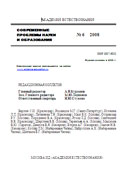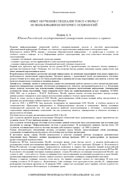PDF-версия статьи


|
The term multimedia is also used to refer to media, allowing you to store large amounts of data and to ensure sufficient access to them (the first carriers of this type were CD - compact disk). In this case, the term multimedia implies that the computer can utilize such carriers, and provide information to the user through all the possible types of data, such as audio, video, animation, and other image, in addition the conventional methods provide information such as text.
Multimedia allow intensification of training and increasing the motivation of learning through the use of modern methods of treatment of the media, such as:
─ «manipulation» (overlay, moving) visual information, both within the field of the screen, and within the field of the previous (subsequent) screen;
─ contamination (mixing) of various media; realization of animation effects;
─ deformation of visual information (increase or decrease in a particular linear parameter, stretching or compression of the image);
─ discrete feed media;
─ toning image;
─ fixing a selected part of the visual information for subsequent removal or consideration "under the microscope";
─ multi-window view of the media on the same screen with the ability to activate any part of the screen (for example, in one box» ─ a video in another ─ the text);
─ demonstration of actual processes taking place in real-time event (video).
Media can be roughly classified as linear and nonlinear.
The analog linear mode of representation can be a movie. A man looking through this document can not its output.
Nonlinear reporting method enables a person to participate in the output information, interacting in any way with the display means of the multimedia data. human participation in this process is also called "interactivity". This way of human-computer interaction the most complete way is presented in the categories of computer games.
Creating hypertext documents that there is a special language SGML (Standard Generalized Markup Language). It is a toolkit create structured documents mechanisms, marked by a descriptor. The entire process is divided into three separate steps: creating, processing and formatting of the document. Therefore SGML technology makes a huge win in the preparation of materials to be output in different ways. Documents containing SGML tags, with a special style sheet may be variously formatted when displayed on the CD-ROM or printed. SGML is a meta-language and allows to describe other types of markup language used to create documents. One of these languages - HTML (HyperText Markup Language) - is well known to anyone who is developing a page for the World Wide Web. However, its descriptors (tags) are not enough to present a document in the same way even in different types of browsers , and even more so for the introduction of its membership multimedia components.
These limitations have created a new language XML (eXtensible Markup Language), designed to replace HTML and at the same time solve the problem of equal representation of documents regardless of the output method. He develops the HTML capabilities, allowing the construction of complex hypertext links from one source to many destinations and the creation of broader, more structured documents through the use of tags lower level. XML also allows you to create custom tags (which is impossible with the help of HTML), and separates the contents of the document on the format of its presentation.
1. Multimedia Technologies Ashok Banerji & Ananda Mohan Gohos, Hill Education Private Limited, 2016 ISBN 978-0-07-066923-9, 314 pages.
2. Discovery Science, Džeroski, S., 2016.
3. Multimedia Database, Retrieval Paisarn Muneesawang, Ning Zhang, 2017.
ОПУБЛИКОВАНО
Karibay G.Zh., Rahimbek N.Zh., Alishova S.S., Bibulova D.A., Utelbaeva A.K. Development of the multimedia technologies. // Современные проблемы науки и образования - 2017.-№6. (приложение "Педагогические науки"). - C. 6